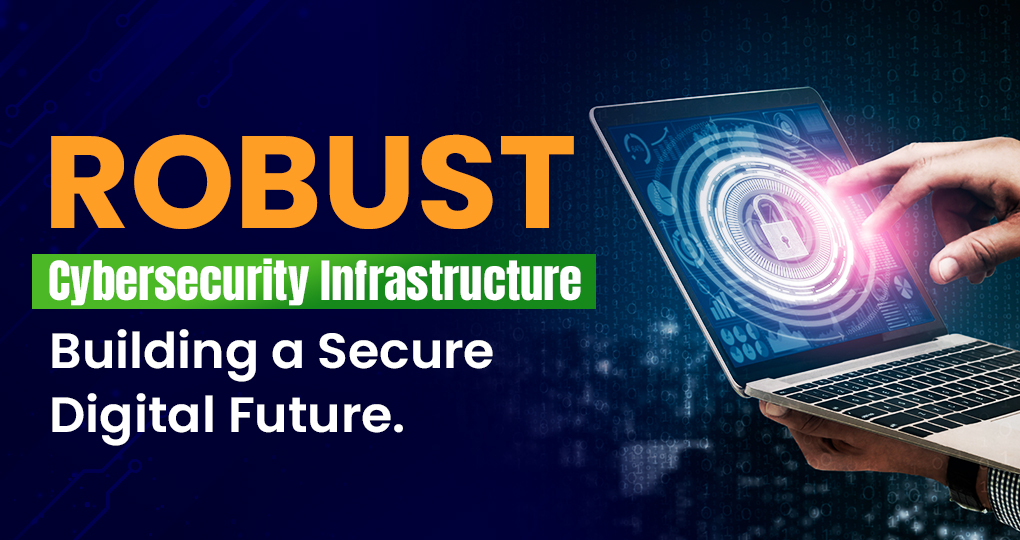Network Remedy Blog

Robust Cybersecurity Infrastructure: Building a Secure Digital Future
In today’s digital age, cybersecurity has become a critical component of any organization’s infrastructure. Cyberattacks are becoming more frequent and sophisticated, and the consequences of a successful attack can be devastating. It is essential to have a robust cybersecurity infrastructure to protect against these threats.
Brief overview of the importance of cybersecurity
Cybersecurity is the practice of protecting computer systems, networks, and sensitive information from unauthorized access, theft, or damage. With the increasing use of technology in all aspects of business, the importance of cybersecurity cannot be overstated. A successful cyberattack can result in the loss of sensitive data, financial loss, and damage to the organization’s reputation.
Introduction to Network Remedy’s insights on building a robust cybersecurity infrastructure
Amon Prasad, the visionary leader behind Network Remedy, Inc., plays a central role in shaping the organization’s cybersecurity stance. Understanding the organization’s goals and objectives is imperative for establishing a resilient cybersecurity infrastructure. Amon, as the CEO, prioritizes and sets the precedence for cybersecurity, ensuring that every employee comprehends its significance.
His responsibility extends to crafting a cybersecurity framework, outlining policies, procedures, and standards to safeguard against cyber threats. Regular review and updates of this framework are vital for maintaining its efficacy against evolving threats.
Amon Prasad underscores the significance of establishing a resilient cybersecurity infrastructure for organizations committed to safeguarding sensitive information and maintaining a stellar reputation. Leveraging his extensive experience, he emphasizes the crucial role of securing private information in the overall success of businesses. Covering diverse aspects from marketing trends to safeguarding clients’ personal details, Amon’s insights are featured in the blog post titled “Top 5 Entrepreneurs Going into 2024,” providing deeper perspectives on this critical matter.
Understanding the Cybersecurity Landscape
Cybersecurity is a constantly evolving field with new threats and vulnerabilities emerging every day. Understanding the cybersecurity landscape is crucial for developing and maintaining a robust cybersecurity infrastructure.
The evolving nature of cyber threats
Cyber threats are becoming increasingly sophisticated and complex. Attackers are constantly developing new techniques and tools to breach security systems and gain access to sensitive data. The rise of the Internet of Things (IoT) has also created new attack surfaces, as more devices are connected to the Internet.
To combat these threats, security infrastructure development needs to be resilient and adaptive. This means that cybersecurity systems need to be designed with the ability to detect and respond to new threats in real-time.
Resilient cybersecurity systems can withstand attacks and continue to function even in the face of a breach. This requires a multi-layered approach to security that includes both preventative measures and incident response plans.
In essence, acquiring a comprehensive understanding of the cybersecurity landscape is vital to crafting a resilient cybersecurity infrastructure capable of defending against the ever-changing landscape of cyber threats. Keeping abreast of the latest threats and vulnerabilities ensures that organizations fortify their cybersecurity systems, making them robust and resilient in the face of potential attacks.
Key Components of a Robust Cybersecurity Infrastructure
To ensure that a company’s cybersecurity infrastructure is robust and secure, several key components must be in place. These components include network security, endpoint security, data protection and encryption, employee training and awareness, and regular security audits and assessments.
Network Security
Network security is a critical component of a robust cybersecurity infrastructure. It involves securing the network perimeter, monitoring network activity, and controlling access to the network. This can be achieved through the use of firewalls, intrusion detection and prevention systems, and virtual private networks (VPNs).
Endpoint Security
Endpoint security involves securing individual devices such as laptops, desktops, and mobile devices. This can be achieved through the use of antivirus software, firewalls, and intrusion detection and prevention systems. Endpoint security also involves controlling access to devices and ensuring that devices are updated with the latest security patches.
Data Protection and Encryption
Data protection and encryption involve securing sensitive data both in transit and at rest. This can be achieved through the use of encryption technologies such as secure sockets layer (SSL) and transport layer security (TLS). It also involves implementing data backup and recovery solutions to ensure that data can be recovered in the event of a security breach or disaster.
Employee Training and Awareness
Employee training and awareness are critical components of a robust cybersecurity infrastructure. This involves training employees on how to identify and report security threats, as well as educating them on best practices for securing sensitive data. It also involves implementing policies and procedures that promote good cybersecurity hygiene.
Regular Security Audits and Assessments
Regular security audits and assessments are essential for ensuring that a company’s cybersecurity infrastructure is robust and secure. This involves conducting regular vulnerability assessments, penetration testing, and security audits to identify and address potential security threats. It also involves implementing a continuous monitoring program to ensure that the company’s cybersecurity infrastructure remains secure over time.
Overall, a robust cybersecurity infrastructure requires a combination of information security measures and data protection solutions. By implementing key components such as network security, endpoint security, data protection, and encryption, employee training and awareness, and regular security audits and assessments, companies can ensure that their cybersecurity infrastructure is secure and resilient to potential threats.
The Role of Leadership in Cybersecurity
Effective leadership is crucial for promoting robust cybersecurity infrastructure. Leaders play a key role in setting the cybersecurity agenda, establishing policies and procedures, and ensuring that cybersecurity is integrated into every aspect of an organization’s operations.
Leadership strategies for promoting cybersecurity awareness
Leadership strategies for promoting cybersecurity awareness include:
- Training and education: Leaders should provide training and education to employees on cybersecurity best practices, such as how to identify phishing emails and how to create strong passwords. This will help to ensure that employees are aware of the risks and can take appropriate action to protect themselves and the organization.
- Communication: Leaders should communicate the importance of cybersecurity to all employees, stakeholders, and partners. They should also ensure that there is open communication between all parties so that potential threats can be identified and addressed as quickly as possible.
- Risk management: Leaders should implement risk management strategies that include regular risk assessments, vulnerability testing, and incident response plans. This will help to ensure that the organization is prepared for any potential cybersecurity threats.
- Network defense strategies: Leaders should implement network defense strategies that include firewalls, intrusion detection systems, and other security measures. They should also ensure that all software and hardware are regularly updated and patched to prevent vulnerabilities from being exploited.
To sum it all up, effective leadership is essential for promoting robust cybersecurity infrastructure. Leaders must take a proactive approach to cybersecurity, implementing policies and procedures that promote awareness, communication, risk management, and network defense strategies. By doing so, they can help to ensure that their organization is protected against potential cyber threats.
Implementing Best Practices
Implementing best practices for a robust cybersecurity infrastructure is crucial for organizations to protect their internal network infrastructure from cyber threats. Here are some best practices that can be used to implement a strong cybersecurity infrastructure:
Network Security Measures
Organizations should implement robust network security measures to protect their network infrastructure. This includes implementing firewalls, intrusion detection and prevention systems, and access control mechanisms to prevent unauthorized access to the network.
Defense in Depth
Following best practices for implementing defense in depth is important to ensure that organizations have multiple layers of security to protect against cyber threats. This includes implementing security measures at the network, system, and application levels.
Regular Software Updates
Regular software updates are important to ensure that all systems are up-to-date with the latest security patches and fixes. This helps to prevent vulnerabilities that can be exploited by cyber threats.
Employee Training
Employee training is crucial to ensure that employees are aware of the risks associated with cyber threats and how to prevent them. This includes training on how to identify phishing emails, how to create strong passwords, and how to report any suspicious activity.
Incident Response Plan
Having an incident response plan in place is important to ensure that organizations are prepared to respond to any cyber threats that may occur. This includes having a plan in place to detect, analyze, and respond to any security incidents that may occur.
By implementing these best practices, organizations can create a strong and robust cybersecurity infrastructure to protect against cyber threats.
Encouragement for organizations to prioritize cybersecurity
Cybersecurity threats are becoming increasingly sophisticated, and organizations need to take proactive measures to protect their assets. A robust cybersecurity infrastructure is essential to ensure the confidentiality, integrity, and availability of sensitive data. However, many organizations fail to prioritize cybersecurity due to various reasons, such as lack of resources, lack of awareness, and lack of motivation.
To encourage organizations to prioritize cybersecurity, there are several strategies that can be implemented. One such strategy is to provide incentives for organizations that invest in cybersecurity. This can be in the form of tax breaks, grants, or other financial benefits. By providing such incentives, organizations are more likely to prioritize cybersecurity as they see a direct benefit to their bottom line.
Another strategy is to raise awareness about the importance of cybersecurity. This can be done through training programs, workshops, and seminars. By educating employees and stakeholders about the risks of cyber threats, organizations can create a culture of cybersecurity awareness that permeates throughout the organization.
Organizations can also prioritize cybersecurity by implementing best practices, such as regular security audits, vulnerability assessments, and penetration testing. These measures can help identify vulnerabilities in the system and provide a roadmap for addressing them.
Overall, prioritizing cybersecurity is essential for organizations to protect their assets and maintain their reputation. By providing incentives, raising awareness, and implementing best practices, organizations can create a robust cybersecurity infrastructure that can withstand the ever-evolving threat landscape.
If you’re looking for a reliable and experienced cybersecurity provider in Santa Clara, look no further than us. Contact us today to learn more about our Network Remedy services and how we can help your business succeed.
Frequently Asked Questions
What are the current cybersecurity threats?
The current cybersecurity threats include but are not limited to ransomware, phishing attacks, and data breaches. Ransomware is a type of malware that encrypts a victim’s files and demands payment in exchange for the decryption key. Phishing attacks are attempts to trick victims into providing sensitive information such as usernames, passwords, and credit card numbers. Data breaches are unauthorized access to sensitive or confidential information, often resulting in the theft of personal data.
How can organizations stay resilient in the face of cyber threats?
Organizations can stay resilient in the face of cyber threats by implementing a robust cybersecurity infrastructure. This includes having a comprehensive security policy, conducting regular security assessments, and providing ongoing security awareness training to employees. It is also important to have a plan in place for responding to security incidents and to regularly test and update this plan.
How does Network Remedy prioritize cybersecurity within the organization?
Network Remedy places a high priority on cybersecurity within the organization by fostering a culture where every employee recognizes and understands the significance of cybersecurity. This commitment extends beyond mere acknowledgment to the active integration of cybersecurity principles into the daily operations and mindset of the entire workforce.
What strategies should be employed to maintain a secure cyber environment for remote workers?
To maintain a secure cyber environment for remote workers, organizations should implement policies and procedures for secure remote access, such as using virtual private networks (VPNs) and multi-factor authentication. It is also important to provide ongoing security awareness training to remote workers and to ensure that all devices used for remote work are properly secured and updated with the latest security patches. Additionally, organizations should regularly monitor and audit remote access logs to detect and respond to any security incidents.





